The expected market revenue for the workplace safety market will reach USD 2,189.4 million by 2030. The question arises: Why the sudden surge?
Undoubtedly, more companies are now making workplace safety an organizational pillar. About 41% of employees leave an organization because of unsafe conditions (report by AllVoices). So, in case you’re neglecting your company’s safety standards, you might lose half of your workforce.
But what defines high safety standards, especially for high-risk industries like manufacturing, oil & gas, healthcare, construction, etc?
For such high-risk industries, enhanced regulatory compliance, safety management, and incident reporting are the top inclusion priorities. With these, adhering to safety frameworks becomes effortless and easy.
Your one-stop solution for all these is EHS software. It ensures seamless compliance and risk management with features like centralized compliance tracking, risk identification, incident tracking, and real-time reporting.
KPA Application is one such EHS platform widely known for its operational efficiency. In this blog, we will discuss the top 7 KPA Flex alternatives that align best with your business’s growing needs. But first, let us see why KPA lacks the evolving demands for businesses.
Why KPA Application Might Not Be The Best EHS Software For Your Business?
KPA, cloud-based EHS software, can systematically manage workplace safety, regulatory compliance, and environmental responsibilities. But here is why businesses shift to other platforms:
- Complex User Experience: Designed specifically for safety professionals, the user experience for KPA is perceived as complex due to its extensive configurability and feature set. The platform demands a high learning curve, especially for the frontline workers.
- Limited Flexibility: The platform, ideal for traditional EHS compliance, offers limited flexibility for important features like management forms. The lack of flexibility results in inefficiency in data tracking and reporting, ultimately reducing proactive risk management efficiency.
- Lack of Collaboration Tools: The tool has some robust functionalities like reporting, equipment assessment, and audits & inspections. But the new-age operational needs prioritize platforms that offer real-time communication and collaboration tools for faster response times, reduced downtime, and minimized risk of escalation.
- Gaps in Features: KPA has a longstanding position in the market that focuses primarily on traditional EHS safety and compliance. The platform lacks advanced features like mobile-first capabilities, flexible workflow customization, and AI-powered automation, causing operational delays and inconsistencies.
Now, let’s look at our top 7 picks for KPA alternatives.
Overview of 5 Best KPA Flex Alternatives
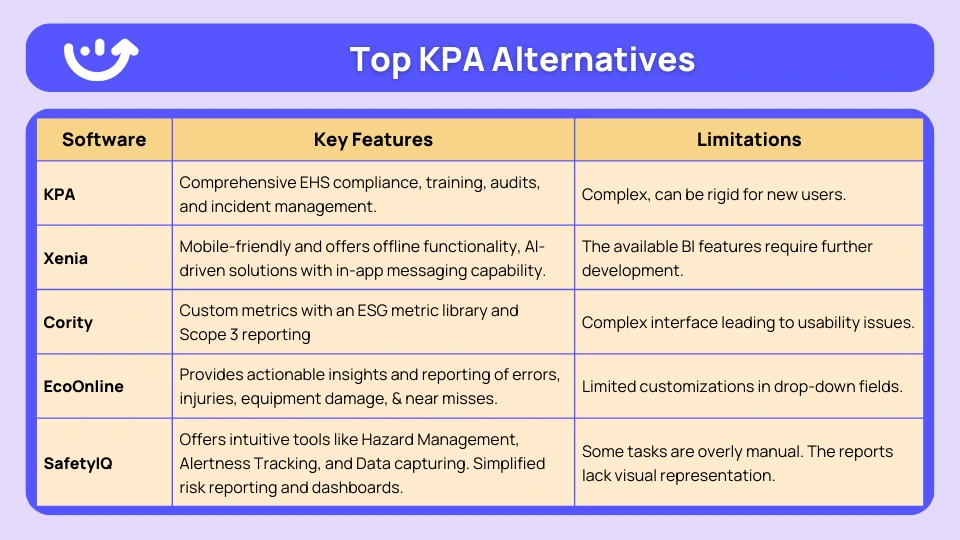
.svg)
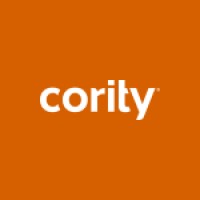
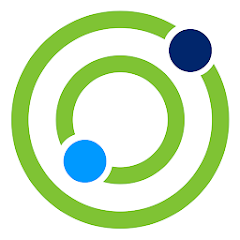
Enhance Your EHS Management with These KPA Competitors
1. Xenia - Our Top Pick as an EHS App
Xenia: Best for businesses requiring a unified platform that offers automated compliance reports and integrated regulatory requirements, simplifying the EHS operations.
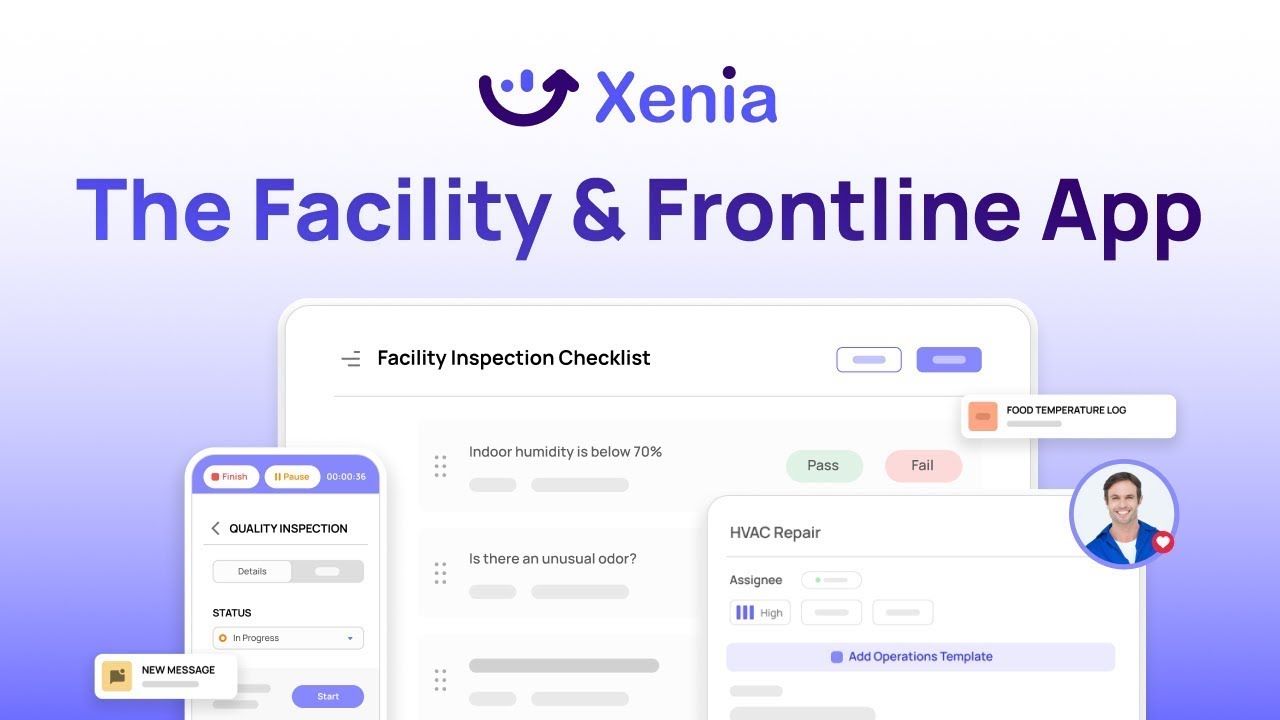
As discussed earlier, KPA’s interface and mobile features can feel outdated compared to newer, more modern EHS solutions. Unlike KPA, Xenia is an AI-powered operations execution software purpose-built on the latest technology, with features that meet market needs.
Xenia emerges as a strong competitor to KPA with its new-gen AI capabilities. Platforms like KPA, which operate manual inspections and reactive measures, cause inefficiency and inaccuracies.
However, Xenia combines extensive operation execution, employee training, audits & inspections, task management, and analytics capabilities to help businesses stay competitive and efficient in fast-paced environments.
With the following capabilities of Xenia, the EHS risk management is made 10X smarter:
Xenia's Key Features:
AI Predictive Analysis
As you start your operational journey with Xenia, you settle in for a safe future for your business. Xenia’s AI-powered pattern recognition analyzes your historical operational data across locations to identify trends before they become problems.
No more downtime surprises, as identifying potential hazards and incidents becomes much easier with Xenia’s predictive analytics reports. What makes Xenia better than other competitors is that the system uses automated alerts to notify about any abnormal patterns so that teams can respond promptly and take immediate action.
Intelligent Alert Systems
Xenia’s alerts aren’t simple system notifications that only buzz your devices. Xenia’s intelligent alert system not only identifies issues and errors in your operations, but also timely reports them to the concerned person. Moreover, alerts are prioritized based on severity, time of day, location, and role responsibility, so that they’re resolved as quickly as possible.
Here’s a comparison of how Xenia’s Intelligent Alert System will work in two different scenarios:
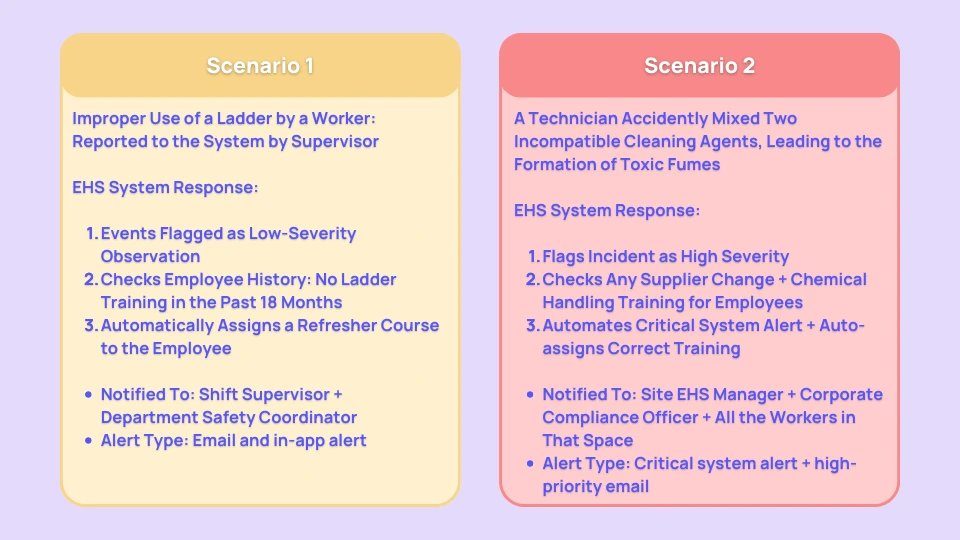
User-Friendly Interface
You don’t want your workers, especially the frontline workforce, to take on an additional responsibility, i.e., be a tech wizard.
What most EHS app providers forget is that the entire organization uses the software, with a great proportion of employees with limited tech experience. Xenia is a dedicated frontline operations app that offers a friendly interface that your entire workforce will love, simply because it is so easy to use.
Xenia is mobile-friendly and offers offline functionality so that field workers actually adopt and use it. They can be active anywhere, anytime, and their work will automatically sync up when they are in the network.
Integrated Team Communication
Picture this:
An employee in an Oil & Gas organization sees an oil spill. His email lands in the manager’s inbox with 99+ unreads. Hours later, the manager responds. But… the spill has already spread and damage is done. If only there were an integrated communication channel and a solution could be communicated much quickly.

Xenia in-app messaging ensures your team doesn’t jump across different channels for simple questions, asks, responses, etc. Employees can have real-time conversations with team chats and broadcast company-wide announcements when needed. Additionally, Xenia’s photo annotation capabilities make issue correlation analysis quick, ensuring EHS Safety.
Health & Safety Management
What could make your workplace’s EHS management smoother than ever? The answer is a platform that lets you efficiently manage all the documentation, insights, reporting, and operations that concern safety in one place.
Xenia offers a centralized place for compliance tracking, safety standards, environmental regulations, and other requirements specific to your industry.
With AI-driven operations, the task management is automated while ensuring consistent compliance, making processes time-efficient and avoiding unnecessary penalties.
Why Xenia meets every requirement:
Seamless Integration
Imagine an EHS platform leaving no place for inefficiency, risks, and operational blind spots —All because of its seamless integrations.
Xenia’s pre-built integrations with major platforms mitigate this risk by providing public API integration with the existing system. The critical systems, like HR, POS, IoT/Sensors, and maintenance systems, can be integrated with Xenia with no development help.
What does this unified approach offer to organizations?
No multiple entries in different systems, lower inaccuracies, and no information siloes.
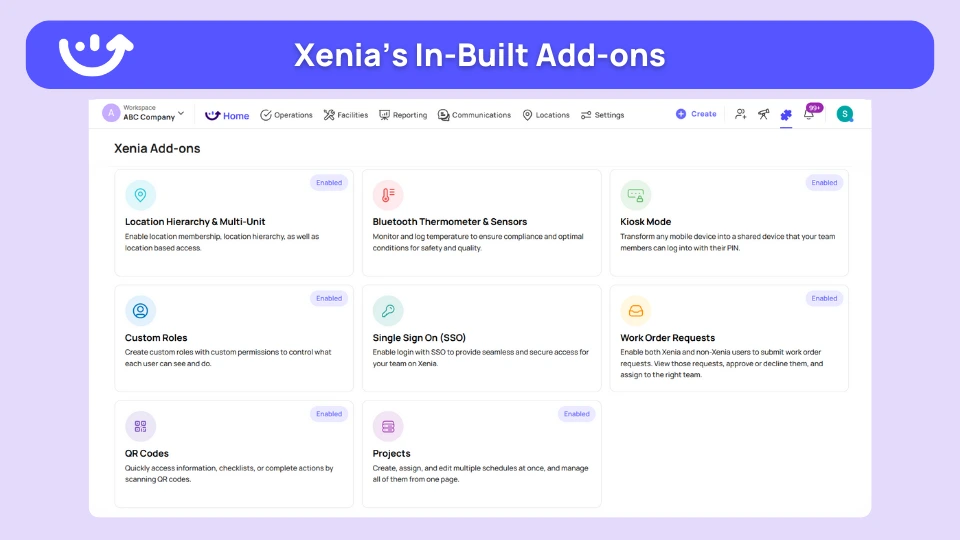
Compliance Management
Compromising on your compliance management goes beyond tracking the certifications and legal fines. One inaccuracy in tracking a safety violation can make it hazardous for the workers, or worse, it can increase the chances of consistent oversights.
Here are Xenia’s stand-out features and how they overall help businesses efficiently implement EHS-related processes:
- With Xenia’s pre-built compliance checklist library, the staff can be trained with no errors, resulting in minimal to no accidental non-compliance.
- The system informs you about renewals and expirations with set automation, which helps businesses avoid legal fines and troubles.
- The platform helps managers stay up-to-date with current and emerging EHS regulations (like OSHA safety standards, environmental regulations, and health department compliance)

Preventive Maintenance
With Xenia, you can automate recurring tasks and procedures to keep your operations running smoothly. For example, the walk-in freezer must go through a deep clean once every 2 weeks.
You can schedule a task that automatically triggers this schedule according to your set time interval. This ensures the processes meet regulatory maintenance requirements while greatly reducing health & safety incidents.
Digital Task Management
Digital systems for daily tasks execution remove unnecessary manual work by 80%, so that you get to focus on your business’s bigger goals.
With Xenia, you can turn all your daily, weekly, monthly, and yearly tasks, inspections, logs, and SOPs into digital checklists.
Not only do they prevent pencil whooping, but also ensure standardized procedures, streamlined workflows, and enhanced collaboration across teams & locations.

Xenia’s Pricing
Xenia has three pricing plans, including:
Starter - Offers core operations execution, best for growing startups and businesses.
Pro - Covers smarter operations with AI integration in addition to core operations execution.
Enterprise - Provides a full-scale control for complex, multi-location operations, best for established businesses handling extensive operations.
Xenia offers both per-user and per-location-based pricing, so you can pick what your business needs.
See how Xenia streamlines your EHS management! Try for free.
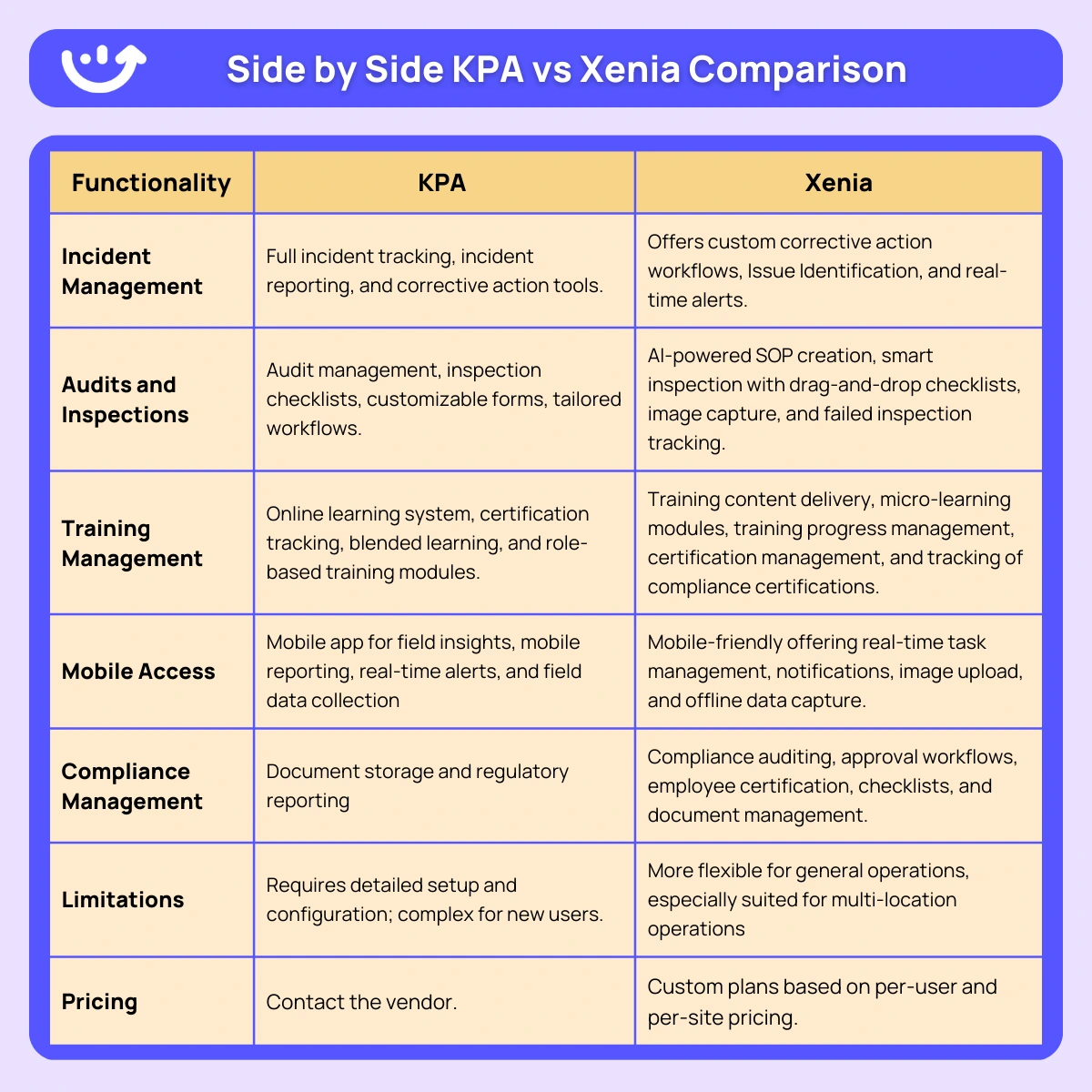
.svg)

Priced on per user or per location basis
Available on iOS, Android and Web
2. Cority

Cority is an all-in-one, fully integrated platform that centralizes all operations. By unifying operations in one platform, the organizations can significantly improve performance by attaining faster response times and reduced duplication of effort.
Here’s a complete guide for Operations Execution Systems! Read now.
Cority provides visual dashboards and custom reports, making data visualization easier. The software features customizable scoring and flagging tools, highlighting risky data points or entities that trigger alerts, notifications, or corrective action workflows.
Key Features:
Optimized Data Collection: With features like custom metrics and an ESG metric library, data collection is customized to industry-specific workflows.
GHG Emissions Calculation: With a simple step-by-step user interface, you can get insights into the carbon footprints of your organizations. You get data for accurate emissions factors and Scope 3 reporting on dedicated dashboards that help make data-driven decisions for environmental safety standards.
Risk Management: The potential risks are evaluated & identified, and improvement goals are assigned to prevent incidents.
Cority's Limitations
For some users with limited technical expertise, navigating and assessing the essential features can be difficult.
3. EcoOnline

EcoOnline makes workplaces safer and compliant with its safety software program and actionable insights. With handling and managing safety standards, you get capabilities like documentation, risk assessment, audit, and reporting in one central position.
Targeting industries like Manufacturing, Construction, Healthcare, Chemical, Logistics and Energy, the strategies match the needs of the frontline workforce. With automatically fed data, the burden of manual work is removed. The safety software handles the data collection, analysis, and reporting, making processes more efficient.
Key Features:
Incident management: The software enables reporting of errors, injuries, equipment damage, and near misses, which helps identify potential causes of recurring or potential incidents.
Flexible Audits and Inspections: With EcoOnline, you can easily build audits, perform inspections, and assign audit actions to implement enhanced safety processes.
Lone Worker App: The tool offers 24*7 protection for lone workers with professional monitoring and response partners.
EcoOnline's Limitations:
The platform offers limited customizations in drop-down fields. In addition, the risk assessment processes and inter-departmental integration are inefficient.
4. SafetyIQ
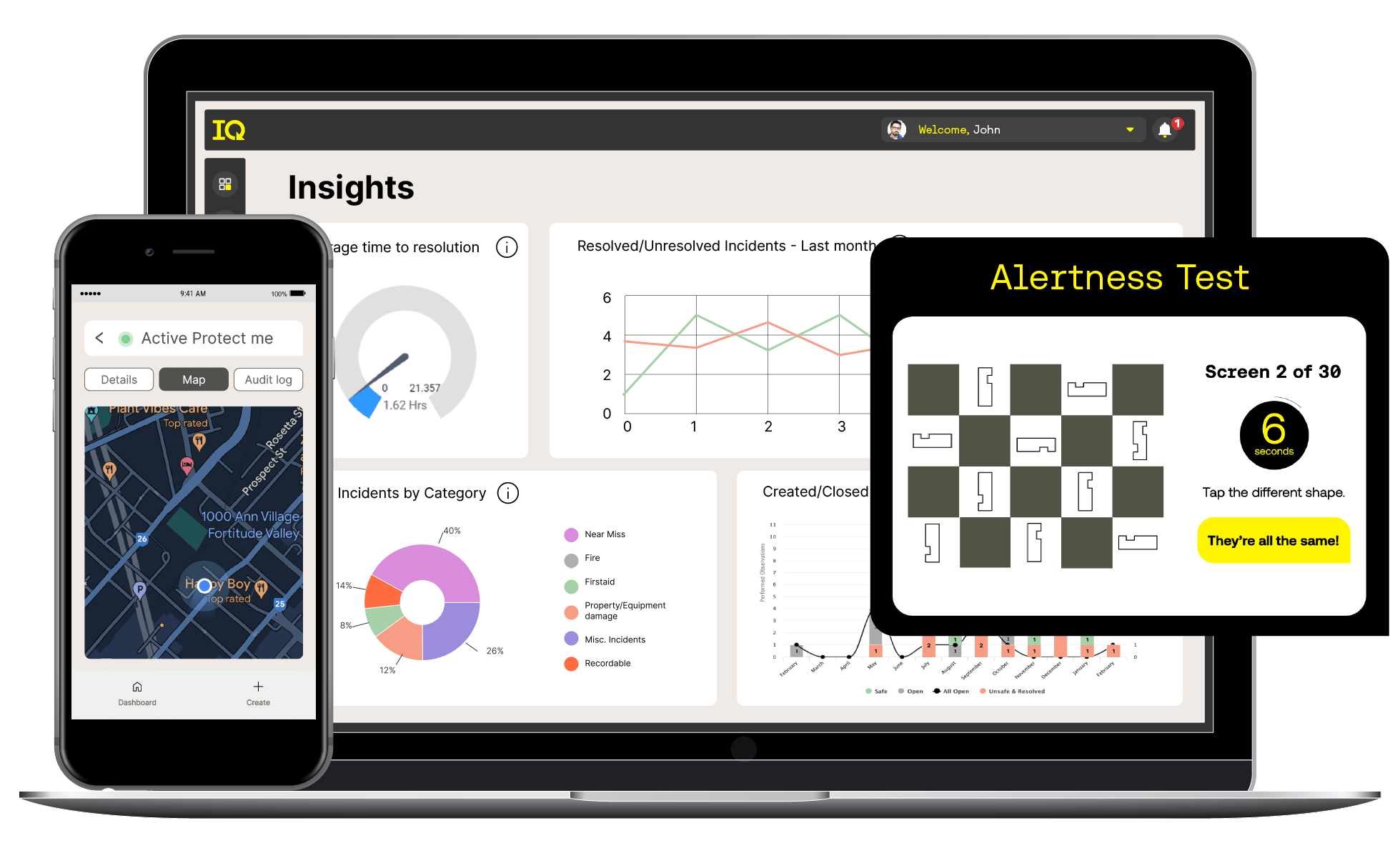
SafetyIQ offers intuitive tools like Hazard Management and Alertness Tracking that reduce risks and enhance workplace safety. This KPA Flex alternative allows data capturing and offers real-time analysis. The simplified risk reporting and dashboards simplify data analysis by improving data understanding and accessibility.
With actionable insights from metrics, the safety standards can be enhanced by closely analysing high-risk controls & safety trends, and then designing proactive measures accordingly. Your workers can use this platform to capture observations, to recognize further, and report any potential cause of hazard.
Key Features:
Hazard Identification: Businesses can identify and report hazards on-site and in real time with the implementation of evidence-based measures, and prevent safety issues from recurring.
Simplified Scoring: SafetyIQ’s scoring system is an easy-to-understand format that also offers integration of visual elements like photos, videos, or voice recordings.
Mobile Friendly: The software is available on mobile.
SafetyIQ's Limitations:
Some tasks, like audit management, are overly manual. The reports lack visual representation, making data interpretation more time-consuming.
5. Intelex
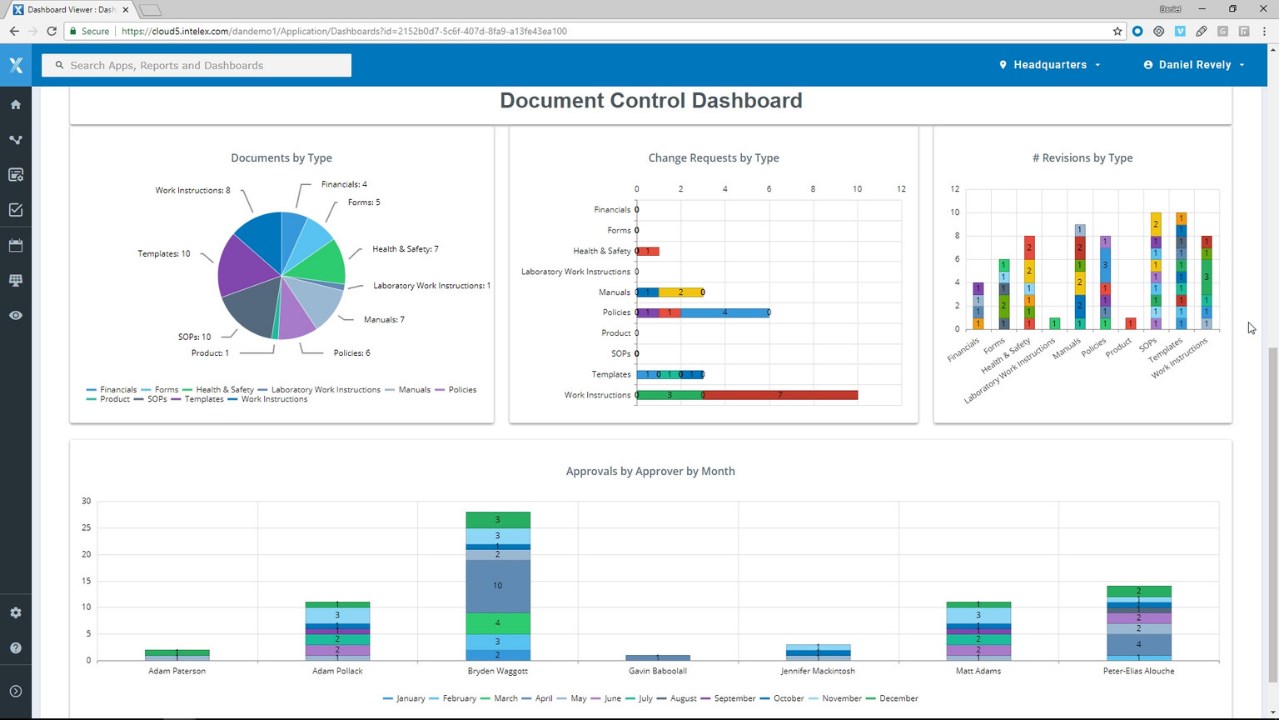
Intelex provides several software solutions to help businesses improve performance across EHS practices, focusing on sustainability and quality. The platform ensures compliance with consistent regulations and safety standards, encouraging a responsible business operation.
With Intelex, the management gets help streamlining documentation while tracking safety training and certification for all employees. Compatibility with other devices ensures the tools can be assessed from mobile devices, ensuring immediate reporting and faster corrective actions.
Key Features:
Communication Management: With Intelex, organizations get a centralized platform to record, organize, and maintain communications of all types, including both internal and external business communications.
Process Hazard Analysis (PHA): PHA helps keep operations organized for processes that use highly hazardous materials.
Comprehensive Mobile Solution: The platform is a mobile-friendly KPA alternative, making it easy for frontline workers to use.
Intelex's Limitations:
Intelex offers third-party integrations, but implementing them might seem complex. Some users also report that the platform is comparatively difficult to use, especially as a first-time user.
6. HSI Donesafe
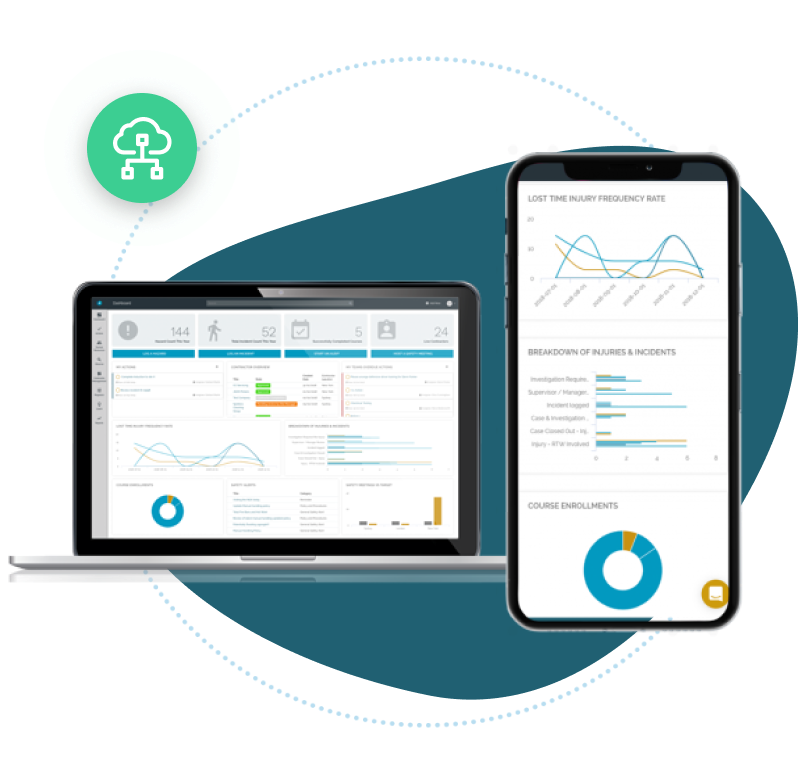
HSI Donesafe facilitates safer and more productive workspaces by integrating EHS management in one place. The platform offers a user-friendly interface without making the processes and operations complex. HSI Donesafe eliminates multiple systems, streamlining data management and making real-time data maintenance and analysis more efficient.
Apart from compliance tracking and interactive dashboards, the platform is highly configurable, enabling the software to adapt to any changes as your business requirements change. HSI Donesafe offers a variety of tools for EHS management, like Incident, Risk, Chemical, Compliance, and Injury Management, making it a scalable option for small businesses.
Key features:
Custom Modules: HSI Donesafe’s drag-and-drop custom builder tools offer flexibility based on your operational demands.
Risk Assessments: HSI Donesafe offers features for risk identification, assessment, and management of psychosocial risks.
Modular and Scalable: Users like that the platform is easy to scale and modify as their business needs.
HSI Donesafe's Limitations:
The only limitation of HSI Donesafe is inefficient analytics and reporting. The reporting dashboard offers limited functionality compared to alternatives like Xenia.
7. SafetyMint
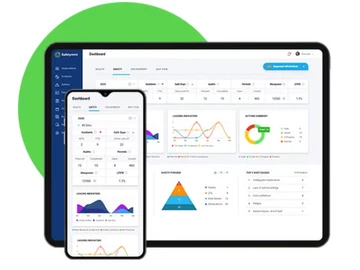
Another good KPA Alternative, replacing traditional safety management practices, is SafetyMint. It offers an easy-to-use and highly collaborative system that ensures a safer work environment. The platform works efficiently on all devices, offering real-time collaboration from anywhere.
The software is best for growing businesses because it offers scalable modules that meet the growing demands based on business operations. The tools offer seamless and inclusive safety management, with customizable workflows that give businesses adaptability for their operations.
Key Features:
Comprehensive Incident and Near-Miss Reporting: Safetymint enables users to capture incidents or near-misses in real time with automated notifications that empower quick, organization-wide responses.
Unified Platform: With safety features like Permit Management, Incident Management, Observation Management, and Audit Management, collaborating with your team becomes easy.
Intuitive Performance Tracking: With dynamic dashboards & detailed real-time data analysis, you can drive measurable improvement in the safety process for your organization.
SafetyMint's Limitations:
The platform lacks seamless integration with existing systems. For larger organizations with industry-specific needs, this can affect their scalability.
Conclusion
Workplace safety has become a core business priority that directly influences operational efficiency and increased productivity. While KPA safety software has been a trusted solution for years, its complexity and outdated features fail to meet the safety standards of the modern workspace.
The market offers modern alternatives with capabilities that enhance the safety practices in the high-risk industries. Xenia, Cority, Safety IQ, EcoOnline, Intelex, HSI Donesafe, and SafetyMint are some of the alternatives that offer scalability to businesses depending on their needs.
Xenia, however, is the top KPA EHS alternative with a user-friendly interface and seamless interactions. The standout feature of Xenia is an integrated communication channel that unifies and enhances collaboration in a team. In addition, the platform offers intuitive dashboards that simplify data analysis and risk prediction.
Request a Demo now and find out how Xenia can streamline your EHS management with its modern capabilities.
FAQs
What Does KPA Software Do?
KPA software is an EHS management platform that streamlines the operational processes to maintain high safety standards. With capabilities like Risk Assessment and Workforce Compliance, KPA Flex helps build safety programs for businesses and take real-time action.
Should I Use KPA Safety Software or Xenia?
KPA has been a leading safety management provider for a long time, but the platform has some outdated capabilities, like a complex interface, limited customizations, etc.
Xenia, on the other hand, leverages modern technologies to make safety operations more efficient. With features like Predictive Analytics, Intuitive Dashboards, Bluetooth Sensors, Xenia stands out as a flexible and user-centric EHS platform.
What Are the Top KPA EHS Software Competitors & Alternatives?
Some of the top KPA EHS software competitors are Xenia, Cority, Safety IQ, EcoOnline, Intelex, HSI Donesafe, and SafetyMint.

.svg)
.webp)
%201%20(1).webp)


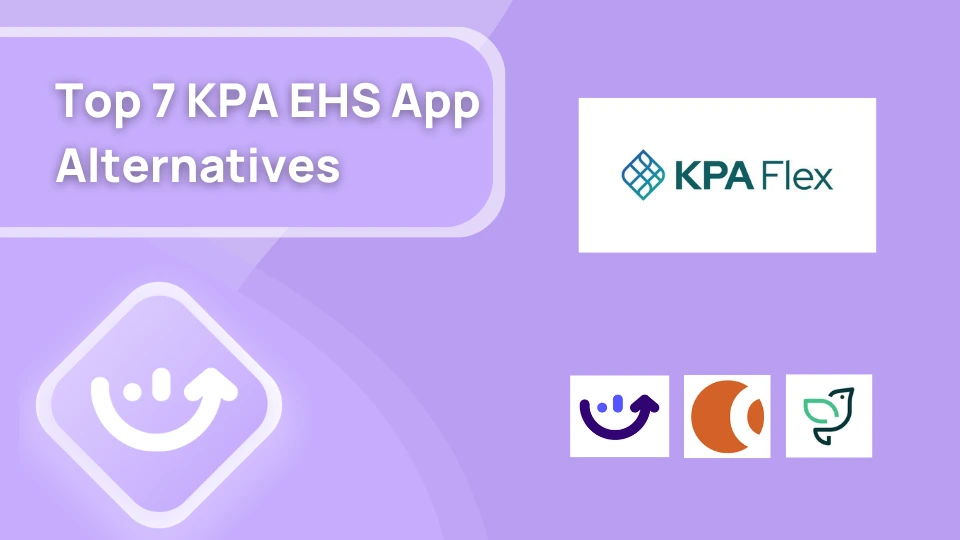



.svg)
%201%20(2).webp)








